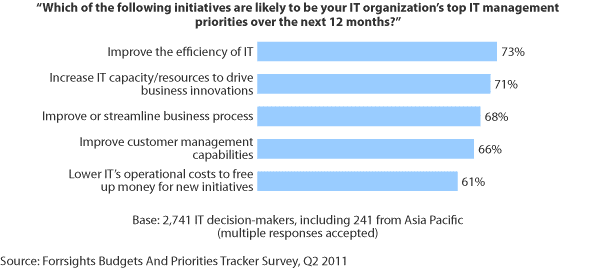BI Adoption Trends In Asia Pacific: High Priority, Poor Execution
Demand for business intelligence (BI) tools, technologies, and approaches is increasing across Asia Pacific (AP). Competitive pressures are driving investments in reporting and decision support to improve operational insights and efficiency. Widespread adoption of mobile technology and social computing has driven interest in visualization capabilities and real-time analytics. Finally, rapidly changing data privacy laws and regulations have forced organizations to implement more stringent information governance capabilities and processes.
Despite growing demand, BI strategies and execution remain immature — poorly implemented and poorly managed — across most of AP. This extends well beyond BI projects to include broader analytics-related investments in areas like information management, data warehousing (DW), and decision support. But while the ROI of BI is consistently underwhelming and the technology often delivers less value to the business than expected, BI-related spending is still set to increase across the region.

Specific BI drivers vary by country, vertical, and organization size in AP, but some drivers are consistent across the region. Users are increasingly demanding the ability to make informed decisions, and there’s a growing understanding across AP that companies need to measure and value assets, processes, and decisions analytically and infuse business processes with added insight, often in real time. With clear, consistent demand, why do most organizations still struggle to deliver value from BI-related investments?
- Typical BI projects and implementations are still tactical and tool-based. Relative to their counterparts in more mature markets in North America and Western Europe, organizations in AP tend to deploy BI in a piecemeal fashion. While projects typically involve a focus on ROI, these are primarily tactical ROIs that only aim to justify the specific project and/or technology. Unfortunately, interviews and discussions with clients across the region indicate that the majority of organizations in AP are struggling to meet even modest expectations in terms of actual value delivery to the business.
- Reporting tools are often the beginning — and end — of BI implementations. Many AP organizations primarily use BI tools for reporting, not for more complex analytics or improved decision-making. This is true even where broader BI investments and technology implementations (including enterprise DW) are in place: Forrester’s Forrsights survey data indicates that 77% of companies in AP are currently using or actively planning to use reporting tools in 2012. The banking, financial services, and insurance (BFSI) and retail sectors are far more likely to have advanced analytics implementations than any other vertical. Among countries, 22% of Australian respondents have implemented mobile BI apps, versus a regional average of 14% and a low of 8% in India.
Access to data and other information is growing dramatically, driven by multiple factors, including the uptake of social computing and cloud computing and increased usage of database appliances and in-memory approaches to data analysis. IT must embrace and support these alongside more traditional data warehousing and reporting infrastructure. But a technology-led approach to BI is almost guaranteed to fail — as is a top-down, IT-led approach. Ensuring user acceptance and cultivating a culture of data-driven decision-making ultimately determines the success of BI initiatives.
